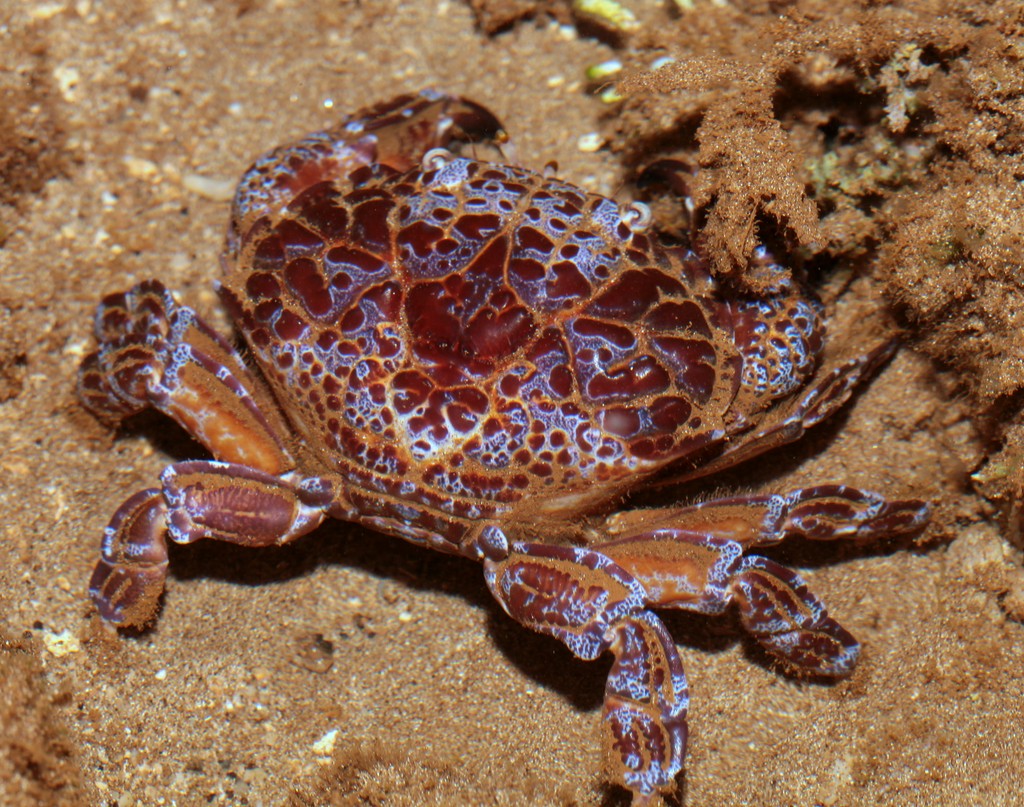ZOSIMUS AENEUS - (LINNAEUS, 1758)
Arthropoda (Phylum) > Crustacea (Subphylum) > Multicrustacea (Superclass) > Malacostraca (Class) > Eumalacostraca (Subclass) > Eucarida (Superorder) > Decapoda (Order) > Pleocyemata (Suborder) > Brachyura (Infraorder) > Eubrachyura (Section) > Heterotremata (Subsection) > Xanthoidea (Superfamily) > Xanthidae (Family) > Zosiminae (Subfamily) > Zosimus (Genus)
Devil crab, Mud crab, Purple-and-orange Xanthid-Crab, Reef crab, True crabs, Teufelskrabbe, 銅鑄熟若蟹, ウモレオウギガニ,
Description
Bords antéro-latéraux de la carapace aplatis, découpés en trois lobes antérieurs et une dent postérieure triangulaire. Bord dorsal de la pince et bords supérieurs des pattes ambulatoires en forme de crête. Couleur blanc-bleuté, marbré de taches rouges. Taille maximum : 9.5 cm TL, généralement : 6.0 cm TL. Profondeur : 0 - 20 m, habituellement : 0 - 6 m.
Distribution
Mer Rouge, Indo-Ouest Pacific : Afrique de L'est, Afrique du Sud, Canal du Mozambique, Madagascar, Mascareignes, Japon, Australie, Nouvelle-Calédonie, Hawaï et Polynésie française.
Biologie
Récif externe et fonds coralliens du lagon. Parfois dans le bas de la zone intertidale. On peut le rencontrer à marée basse marchant sur le platier découvert. Crabes pouvant conduire à de graves empoissonements dont l'issue est souvent fatale. Même cuit la toxine est présente.
Synonymes
Cancer aeneus Linnaeus, 1758)
Cancer amphitrite Herbst, 1801)
Cancer floridus Herbst, 1783)
Zozimus aeneus (Linnaeus, 1758)
Zozymus aeneus (Linnaeus, 1758)
------------------------------------------
Description
Carapace is bright brown dissected with mauve and cream, and the smooth lobules are outlined in white. The carapace is covered with smooth, lobules, which are small and numerous posteriorly. The anteriolateral border is crested with 3 rounded lobes and one tooth (posteriorly). Chelipeds equal, rough surfaced with strong brown fingers with hollowed tips. Max length: 9.0 cm TL, usually: 6.0 cm TL. Depth range: 0 - 20 m, usually: 0 - 6 m.
Distribution
Indo-Pacific, from South Africa to the Red Sea, and as far east as Japan, Australia, New Caledonia, French Polynesia and Hawaii.
Description
Bords antéro-latéraux de la carapace aplatis, découpés en trois lobes antérieurs et une dent postérieure triangulaire. Bord dorsal de la pince et bords supérieurs des pattes ambulatoires en forme de crête. Couleur blanc-bleuté, marbré de taches rouges. Taille maximum : 9.5 cm TL, généralement : 6.0 cm TL. Profondeur : 0 - 20 m, habituellement : 0 - 6 m.
Distribution
Mer Rouge, Indo-Ouest Pacific : Afrique de L'est, Afrique du Sud, Canal du Mozambique, Madagascar, Mascareignes, Japon, Australie, Nouvelle-Calédonie, Hawaï et Polynésie française.
Biologie
Récif externe et fonds coralliens du lagon. Parfois dans le bas de la zone intertidale. On peut le rencontrer à marée basse marchant sur le platier découvert. Crabes pouvant conduire à de graves empoissonements dont l'issue est souvent fatale. Même cuit la toxine est présente.
Synonymes
Cancer aeneus Linnaeus, 1758)
Cancer amphitrite Herbst, 1801)
Cancer floridus Herbst, 1783)
Zozimus aeneus (Linnaeus, 1758)
Zozymus aeneus (Linnaeus, 1758)
------------------------------------------
Description
Carapace is bright brown dissected with mauve and cream, and the smooth lobules are outlined in white. The carapace is covered with smooth, lobules, which are small and numerous posteriorly. The anteriolateral border is crested with 3 rounded lobes and one tooth (posteriorly). Chelipeds equal, rough surfaced with strong brown fingers with hollowed tips. Max length: 9.0 cm TL, usually: 6.0 cm TL. Depth range: 0 - 20 m, usually: 0 - 6 m.
Distribution
Indo-Pacific, from South Africa to the Red Sea, and as far east as Japan, Australia, New Caledonia, French Polynesia and Hawaii.
Biology
Found on outer reefs and coral bottoms of lagoons. It's occasionally found in the intertidal zone at very low tide.
Found on outer reefs and coral bottoms of lagoons. It's occasionally found in the intertidal zone at very low tide.
Both the shell and the meat of Zosimus aeneus contain significant concentrations of neurotoxins including tetrodotoxin and saxitoxin. Tetrodotoxin (TTX) is the compound responsible for the toxicity of puffer fish, while saxitoxin (SXN) is the best known of several related neurotoxins that cause paralytic shellfish poisoning (PSP). Both are absorbed through the gastrointestinal tract and interfere with sodium channels in the membranes of nerve cells. Poisoning with Zosimus aeneus can be fatal.
